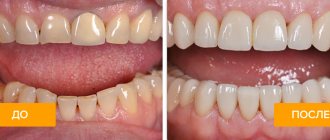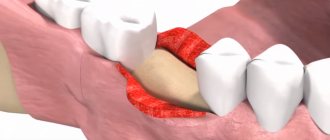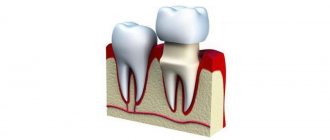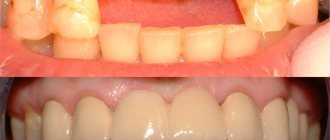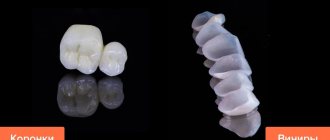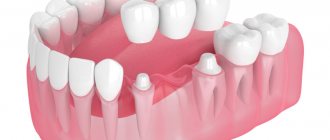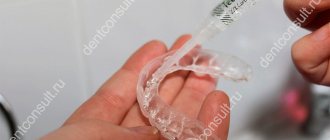Installing crowns is one of the most effective ways to restore teeth. How can you determine that the prosthesis is of adequate quality and that the fixation procedure was carried out according to all the rules? It’s very simple: artificial teeth should not be visually different from real teeth. By and large, such a result can only be achieved if two conditions are met: the doctor installing ceramic crowns must be a true professional, and the structure itself is made of solid ceramics. Andrey Nikolaevich Karneev, leading orthopedist at the German Implantology Center, spoke about what a ceramic crown on a tooth is.
What are the advantages of a ceramic crown?
Today, ceramic dental crowns are the most aesthetically pleasing orthopedic structures installed both in the smile area and on chewing teeth. Ceramics is biologically inert and indifferent, is not perceived by the body as something foreign, does not absorb foreign odors, pigments and bacteria, does not emit harmful substances, and is also very durable. High-quality dentures cannot be distinguished from natural teeth.
3 main advantages of ceramic crowns
- Superior Aesthetics
- Hypoallergenic
- Reliability
Casting technology involving subsequent cladding
With this method of making ceramic products, special molds are used for pouring the porcelain mass. Cast orthopedic structures are characterized by the following advantages:
- flawless surface smoothness;
- lack of junction between the crown and gum when installing the prosthesis.
This method of making dental crowns also has significant disadvantages. It is considered quite complex and time-consuming. Using this method, it is impossible to make bridges.
What types of ceramic crowns are there?
Pressed ceramic crown
The most advanced type is the pressed ceramic crown. The design is highly durable, more accurately reproduces the color of natural teeth, and to install the prosthesis there is no need for strong grinding of the teeth, as is required for fixing structures made from other materials. The last advantage is extremely important, since the service life of the prosthesis depends on the amount of preserved natural dental tissue.
The most famous types of dentures made of pressed ceramics are created using E-max and Empress technologies.
- The E-max ceramic crown is made of lithium disilicate, that is, glass ceramics, which has a high degree of strength and is ideal for prosthetics in both the anterior and chewing regions.
- The Empress ceramic crown is made from the same material, but with the addition of leucite crystals, a mineral of igneous origin. The structures have excellent aesthetic characteristics, but are not able to withstand heavy loads, so they are installed only in the smile area.
Ceramic zirconium crowns
Often, prostheses made of zirconium are classified as metal-free ceramic crowns, which is fundamentally incorrect. Zirconium dioxide is the same metal, only white. Unlike ceramics, it does not have sufficient transparency, and its color palette is very limited. But, on the other hand, this material has good strength. Which crowns are better – ceramic or zirconium? Zirconium dioxide ceramic crowns are more suitable for restoring chewing teeth. In the frontal section, preference should be given to designs made of metal-free ceramics.
Ceramic crowns on a zirconium dioxide frame
A crown on a zirconium base, coated with a layer of ceramics, is the latest development in prosthetics. The white material, unlike metal, does not shine through the porcelain shell, which allows you to achieve excellent aesthetic results with high strength and wear resistance of the structure. In addition, the biocompatibility of a ceramic crown on a zirconium frame eliminates the risk of allergies and periodontal inflammation.
The main stages of making prostheses
The manufacturing process of ceramic dentures involves the following steps:
- diagnostics At this stage, the patient is examined by an orthopedic dentist. After this, the specialist begins to draw up an individual treatment plan;
- preparatory stage. Before installing a ceramic prosthesis, preliminary preparation is necessary: both the tooth itself and the entire oral cavity. For this purpose, professional teeth cleaning is performed and diseases of the teeth and gums discovered during a dental examination are treated. At this stage, the tooth is also depulped and turned, with the help of which it becomes possible to obtain a stump base (the prosthesis will subsequently be placed on this stump base);
- creating an impression from which a model of the future crown will be made.
The production time for a ceramic prosthesis largely depends on the chosen method. When it is ready, the patient comes to an appointment with an orthopedic dentist for fitting and temporary installation of a crown. If no deficiencies are subsequently identified in the finished prosthesis (the patient does not complain of discomfort when using the orthopedic structure), the crown will be permanently fixed to the tooth.
Ceramic crowns for front teeth
Many experts believe that ceramic dental crowns can only be used for prosthetics of the front teeth. Meanwhile, new generation pressed ceramics make it possible to make not only highly aesthetic, but also highly durable structures. The absence of a metal frame in such prostheses is not a sign of fragility or unreliability. Ceramic crowns for chewing teeth also have a place in dental practice.
Main indications and contraindications for dental prosthetics with ceramic dentures
The need for prosthetics may be caused by:
- absence of a tooth located in any part of the dentition;
- the need to eliminate any aesthetic defect (for example, a chipped tooth);
- presence of allergies to metal alloys. Such an allergic reaction makes it impossible to use metal prostheses;
- the need for tooth restoration after injury (provided that the integrity of the tooth root has not been compromised);
- significant tooth destruction (more than 50%).
Dental prosthetics with ceramic products are not performed if the nerve of the tooth is too close or if there is severe periodontitis. The main contraindications to the installation of crowns are discovered already at the diagnostic stage.
How are ceramic crowns placed?
Installing a ceramic crown involves the following steps.
- Preparation. The patient undergoes a visual examination, X-ray diagnostics, canal treatment and gentle grinding of the tooth - the specialist removes much less dental tissue than for crowns made of other materials. An additional advantage is that removal of the nerve is not a prerequisite for attaching a ceramic prosthesis.
- Making a ceramic crown. The doctor takes impressions of the jaws and sends them, along with x-rays, to the laboratory, where a plaster model is made to create an orthopedic structure using one of two technologies:
- hot pressing with layer-by-layer application of ceramics;
- computer modeling CAD/CAM and milling.
If the tooth tissue is severely damaged and there is no reliable base for the prosthesis, a stump inlay is first placed under a ceramic crown. More recently, under similar circumstances, a ceramic crown was installed on a pin, but today the method is outdated and is practically not used in clinics.
- Fixation of a ceramic crown. The procedure is carried out using a special cement or primer, which is polymerized by light. A ceramic crown, like any other, can be placed correctly only by an experienced orthopedist. Poor quality prosthetics leads to inflammatory processes in the gum tissue, tooth destruction and loss of the structure.
Pressing method
This method involves pressing dental crowns made from ceramic mass into special wax molds. Prostheses manufactured using this method have the following advantages:
This method of making dentures involves the use of a special milling machine. The model on which the dental crown will be made is created using a special computer program. This model is then transferred to a milling machine.
Note! The method of manufacturing a ceramic prosthesis significantly affects the cost of the orthopedic structure. Therefore, when developing a prosthetic plan, the specialist decides on the choice of one or another method of making a crown together with the patient.
What is the service life of a ceramic crown?
Metal-ceramic crowns are fixed with dental cement, which breaks down after about 5 to 7 years. However, ceramic dentures are attached to a particularly strong adhesive material, which increases their service life to 10 years.
As for strength, ceramic crowns can easily withstand the required chewing load. If a ceramic crown chips for some reason, it can be easily restored. Since the metal-free structure does not have a frame, almost any minor damage to it will be invisible. If more or less serious damage occurs, the all-ceramic crown can simply be polished.
Photos before and after installation of ceramic crowns at the Research Center. Works by Karneev A.N.
Firing method
This method of producing prostheses involves firing them on a special fire-resistant model made from heat-resistant materials. Products created in this way have many advantages:
- short production times;
- high strength of the finished product.
Various substances are often additionally added to the sintered ceramic mass:
- helping to obtain improved strength characteristics of the prosthesis;
- ensuring the achievement of the desired color of the ceramic prosthesis, which perfectly matches the natural shade of tooth enamel. Note! The advantages of crowns made using the firing method also include their affordable cost.
Restoration of ceramic crowns
Despite the strength of modern ceramic dentures, the query “The ceramic has broken off from the crown, what should I do?” found on the Internet quite often. Typically a defect occurs for the following reasons:
- injury - blow or fall;
- defects in the work of a dental technician;
- malocclusion, bruxism;
- strong mechanical impact on the structure during chewing.
There are two possible solutions to the problem - replacement and restoration.
- Replacement of prosthesis. The crown is removed from the mouth, and the entire prosthetic process is repeated from the moment the impressions are taken until the new structure is attached.
- Restoration. The chip on the ceramic crown is polished to the optimal shape, and a light-curing composite material is placed into the cavity. After hardening, the specialist models the coating, forms bumps and fissures, and grinds uneven edges to the desired size.
The advantages of repair are short time and low cost; chipped ceramics on the crown can be restored in an hour in the dentist’s chair. However, even the use of the most modern materials does not provide the quality that is obtained when making a prosthesis “from scratch” in a dental laboratory. If the cause of the chip was carelessness when chewing hard food, after repair the denture will last for many years. Malocclusions and other pathologies of the dental system reduce the service life of the restored crown several times.
The main advantages of metal-free crowns
The use of ceramic crowns for dental prosthetics involves:
- excellent compatibility of such products with human body tissues. When using ceramic crowns, there are no symptoms of an allergic reaction. The surface of orthopedic products does not change its original color under the influence of external factors and does not darken. In addition, wearing ceramic crowns is not accompanied by a specific metallic taste in the oral cavity;
- aesthetics of products. Strangers will not even notice that you have a prosthesis installed instead of your front teeth;
- individual approach. It became possible thanks to the use of modern technologies. Ceramic dentures are made individually (taking into account the wishes of each patient). The finished product fits well to the stump base without forming any gaps. Achieving high precision in the manufacture of metal-free crowns allows for a long service life. Moreover, it prevents the occurrence of caries in the tooth under the prosthesis;
- low weight of metal-free prostheses. The products are less massive than bulky metal orthopedic structures. Therefore, metal-free crowns are not able to create unwanted stress on the gums and adjacent teeth.
Ceramic products have a completely smooth surface that does not accumulate plaque, does not stain upon contact with food, and does not absorb odors. Despite having many advantages, the products also have certain disadvantages. Such disadvantages should definitely be taken into account by people who want to wear ceramic dentures.
Service life of dental crowns
If you are interested in a tooth crown and what material is best for its manufacture, an important point is the service life of the product. For example, prosthetic devices made of metal-ceramics can be used for 8-10 years, zirconium structures - over 15-20 years, glass-ceramic products - over 15 years.
However, when studying the properties of dental crowns and trying to find out which ones are better suited for prosthetics in a particular area of the jaw, one should not forget about compliance with the patient’s care requirements and the quality of the procedure performed by the dentist.
Under normal conditions, assuming proper training of the doctor and strict compliance with the production concept, the service life of crowns cannot be less than 10 years.
Cost of installing a prosthesis on an implant
A ceramic prosthesis is also placed on an implant. Such services will cost slightly more. The cost of such prosthetics includes the price of the implant itself and the surgical intervention for its implantation. In some situations, preliminary osteoplasty is also necessary. But the high cost in this case is compensated by the durability and reliability of the result.
Note! When installing a ceramic prosthesis on an implant, healthy teeth are not ground down. The price of implant prosthetics depends on many factors:
- the complexity of a particular case;
- types of implant;
- method of manufacturing a ceramic prosthesis;
- implant technology.
You can get detailed answers to all questions regarding dental implantation and prosthetics from specialists at the Alident clinic. Find the beautiful, snow-white smile of your dreams!
CEREC technology. Total information
CEREC is one of the most popular CAD/CAM systems in the world, with its help the dentist has full control over the treatment process, as a result the patient receives a highly aesthetic tooth restoration in one visit to the dental clinic. The essence of the technique is reflected in its name: Chairside Economical Restorations of Esthetic Ceramic - economical restoration with aesthetic ceramics at the patient’s chair. That is, the patient can observe the process of creating a denture using equipment installed in the dental office; he does not need to go home and wait several days for the result. The second version of the name - CEramic REConstrution - also indicates that tooth restoration occurs using ceramics. The prosthetic procedure using CEREC technology takes from one to three hours.
CEREC technology was developed by Sirona (Germany); Sales of CEREC CAD/CAM systems, which made it possible to create ceramic inlays at the patient's chair, began in 1987. Since that time, the CEREC system has been periodically updated and new software has been created. The company produces several types of CEREC devices, dental and X-ray units, scanners, dental instruments and much more. In 2015, Sirona merged with DENTSPLY International, the world's largest manufacturer of dental products and technologies; the merged company was named DENTSPLY SIRONA.
Content:
The quality of dental prosthetics directly depends on the material from which the crowns are made. Today, ceramic structures (other names: metal-free, porcelain, glass-ceramic) are considered one of the best. Ceramic crowns are highly durable and biocompatible. In addition, they cannot be distinguished from natural teeth.
However, the cost of ceramic crowns is several times higher than the cost of metal-ceramic and metal structures. Should you choose ceramics, despite the high cost, or prefer cheaper designs? What is the cost of ceramic crowns in Krasnodar? Besides the high price, are there any other disadvantages to ceramic crowns? How are they made and installed? Are there any contraindications? We will talk about all this in this article.
Distinctive features of ceramics
Until recently, metal-ceramics was considered the most aesthetic and functional material for the manufacture of dental crowns. The metal base, covered with ceramic cladding, made it possible to achieve not only an impeccable appearance, but also high strength. However, the base tends to show through the coating, which is not desirable in the area of the front teeth. In addition, when metal comes into contact with the gum, it changes the color of the mucous membrane, so the aesthetics in the area of the restoration are quickly disturbed in patients.
The properties of ceramics have been revised, and today ceramic crowns without metal and other additives are almost as strong as metal-ceramics. Their high abrasion resistance, durability and the ability to choose a shade allow the design to be used both on the frontal group and chewing teeth. Especially when we are talking about leucite ceramics, that is, pressed ones, in which there are almost completely no pores.
Complex on 4 OSSTEM implants with delayed loading - 140,000 rubles.
Complex implantation Osstem (South Korea) with delayed loading after 4-6 months.
Doctor's work guarantee - up to 5 years (under an agreement on the provision of medical services) Call now or order a call
Opening hours: 24 hours a day - seven days a week
